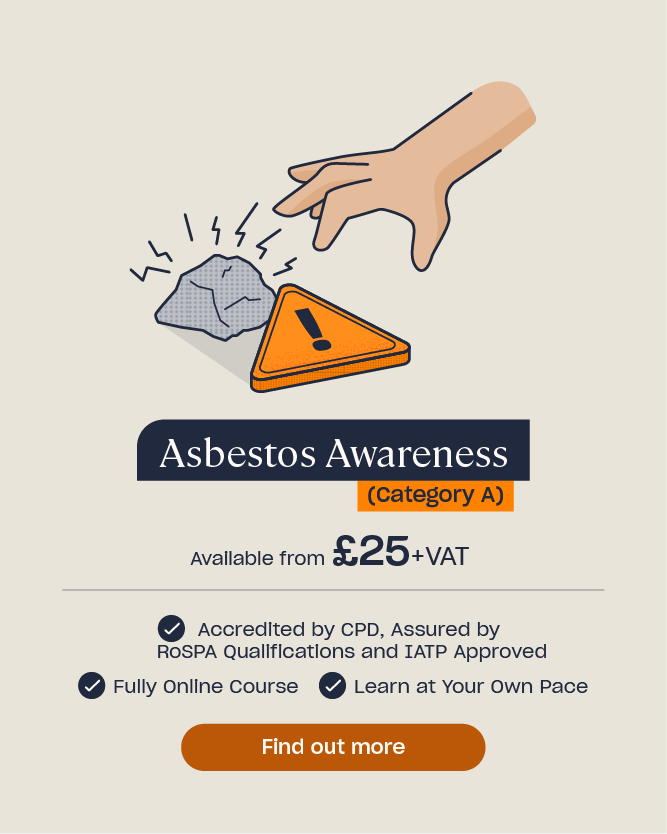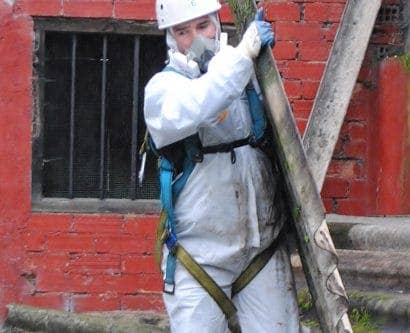Guidance on Mesothelioma and Asbestos
Each year in the UK, more than 2,700 people are diagnosed with mesothelioma – a rare and aggressive form of cancer. There has been an increasing awareness of the link between mesothelioma and exposure to asbestos, a dangerous, naturally occurring substance that is extremely harmful to health.
In this article, we will define mesothelioma and explain how it is linked to asbestos. We will also outline some of the symptoms to look out for and provide guidance on how you can help prevent it.
What is Mesothelioma?
Mesothelioma is a rare form of cancer that develops in the mesothelium, a thin membrane that lines the chest and abdominal cavities. Most commonly, mesothelioma is caused by the inhalation of asbestos and develops in the lungs, known as pleural mesothelioma. However, less commonly, asbestos fibres can also be ingested and cause peritoneal mesothelioma, where the cancer develops in the abdomen. For more information on the different types of mesothelioma, visit the Mesothelioma UK website here.
Pleural mesothelioma causes the lining around the lungs to thicken, restricting lung expansion and causing breathing difficulties. Fluid can also collect between the two layers of the pleura, resulting in breathlessness.
Unfortunately, mesothelioma has a long latency period, meaning that it is typically diagnosed at an advanced stage and is often fatal at the time of diagnosis. It can take 20 to 50 years after the initial exposure to asbestos for symptoms to start showing.
Mesothelioma and Asbestos
Asbestos is a naturally occurring substance that was once widely used in buildings and materials for its fire protection, heat resistant and insulating properties. It was later discovered that asbestos fibres can be easily inhaled or ingested if they are disturbed and, therefore, pose a serious health risk. In fact, asbestos is the largest cause of death for workers in the UK, resulting in over 5,000 deaths every year. You can find more information on the types of asbestos, the dangers it poses and where you are likely to find it in our article here.

According to Mesothelioma UK, the link between asbestos and cancer was first recognised in the 1950s, though the first report linking the fibrous material to mesothelioma specifically wasn’t until 1960. Since then, it has been widely understood that historic exposure to asbestos is the primary cause of mesothelioma, causing more than 95% of cases in men and 85% in women.
Due to the danger of asbestos and its associated risks, the use of asbestos was banned in 1999, but many asbestos-containing materials (ACMs) are still present in properties built before 2000. Therefore, even today, there remains a risk of exposure, and it is essential that proper asbestos management systems and practices are in place for any work that may involve ACMs.
Those people living with mesothelioma often request that we do all we can to prevent others being exposed and put at risk, we are grateful to High Speed Training because working with them enables us to do this. Prevention is always better particularly when sadly, there is no cure.
Mesothelioma UK have enjoyed working with High Speed Training and congratulate them on the quality of their asbestos training materials.
Liz Darlison MBE, CEO of Mesothelioma UK
Need a Course?
Our Asbestos Awareness Training, made in partnership with Mesothelioma UK, provides you with the essential knowledge you need to help keep yourself and others safe from the risks of asbestos exposure.
Symptoms of Mesothelioma
As stated earlier, symptoms of mesothelioma can take many years to develop and often mimic those of other, less severe conditions.
Common symptoms of pleural mesothelioma include:
- A persistent cough.
- Chest pain.
- Shortness of breath.
- Fatigue.
- A high temperature and sweating, particularly at night.
- A loss of appetite and unexplained weight loss.
For peritoneal mesothelioma, common symptoms include:
- Abdominal pain or swelling.
- Loss of appetite or unexplained weight loss.
- Nausea and vomiting.
- Diarrhoea or constipation.
This is not an exhaustive list, but these symptoms are commonly associated with an underlying health issue and should, therefore, always be addressed.
If you believe you could have been exposed to asbestos, either recently or in the past, you must speak with your GP and ensure that information is recorded in your notes.

How to Prevent Mesothelioma
As asbestos is the main cause, the best way to prevent mesothelioma is to avoid exposure to it. Under the Control of Asbestos Regulations 2012, written management plans should be in place if any work has the potential for exposure to asbestos. Speak to your manager or employer about the risk assessments and safety measures they have in place to mitigate exposure. All employees have every right to ask questions, raise concerns and request further information regarding the safety measures taken – you must never continue working if you are concerned about exposure to asbestos fibres, even if instructed to do so. Understanding the dangers that asbestos poses is vital to protecting health and welfare. By law, if your profession involves work involving potential contact with ACMs, you must be trained to keep yourself and others safe from harm. It is important that you comply with training, follow any workplace procedures and work in accordance with any safety measures required, such as avoiding certain areas and using certain personal protective equipment (PPE) or respiratory protective equipment (RPE) when advised.

Anyone at risk of potential exposure should understand the specific, immediate actions that need to be taken should this event occur. Visit our article for more information on what to do if you’re exposed to asbestos here.
Follow our Asbestos Awareness tag on the Hub for more information and all our asbestos-related content.
Further Resources:
- Asbestos Awareness Course (Category A)
- What to Do if Exposed to Asbestos
- Asbestos Colours: What is the Most Dangerous Asbestos Colour?











